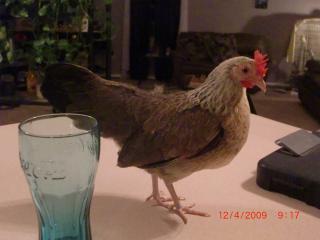Quote:
We ended up keeping a young Moser hen that I believe would be Pearls full sister, her name is Biscuit. We had some odd colors come out of that pen. We had what ended up looking like a splash out of BLB roo and CLB hens--even if I marked the egg wrong, we had no pens set up that would result in splash offspring because we didn't want any splash.
The only other possibility is a recessive diluter of black like lavender (which would also explain the lightness of the 'red' on the bird). If it is Lavender, then Pearl might be carrying it.
I would love to investigate further, but my sister is concentrating more on MGB right now. The 'Splash' roo was sold with a trio of unrelated CLB hens. He was in a bachelor pen, and was a very happy little roo when he got his hens! I would love to see what the progeny out of that cross looks like!
Pearl came from your "H" pen. Harvey's egg was marked with a star. So I don't think she came from that pen...though the possibility of carrying the Lav gene would have been pretty cool.

With the CLB and BCLB, I would expect to get CLB and BCLB offspring, right?
I cannot wait for spring so I can hatch some itt bitty Dutch chicks!

We ended up keeping a young Moser hen that I believe would be Pearls full sister, her name is Biscuit. We had some odd colors come out of that pen. We had what ended up looking like a splash out of BLB roo and CLB hens--even if I marked the egg wrong, we had no pens set up that would result in splash offspring because we didn't want any splash.
The only other possibility is a recessive diluter of black like lavender (which would also explain the lightness of the 'red' on the bird). If it is Lavender, then Pearl might be carrying it.
I would love to investigate further, but my sister is concentrating more on MGB right now. The 'Splash' roo was sold with a trio of unrelated CLB hens. He was in a bachelor pen, and was a very happy little roo when he got his hens! I would love to see what the progeny out of that cross looks like!
Pearl came from your "H" pen. Harvey's egg was marked with a star. So I don't think she came from that pen...though the possibility of carrying the Lav gene would have been pretty cool.

With the CLB and BCLB, I would expect to get CLB and BCLB offspring, right?
I cannot wait for spring so I can hatch some itt bitty Dutch chicks!









